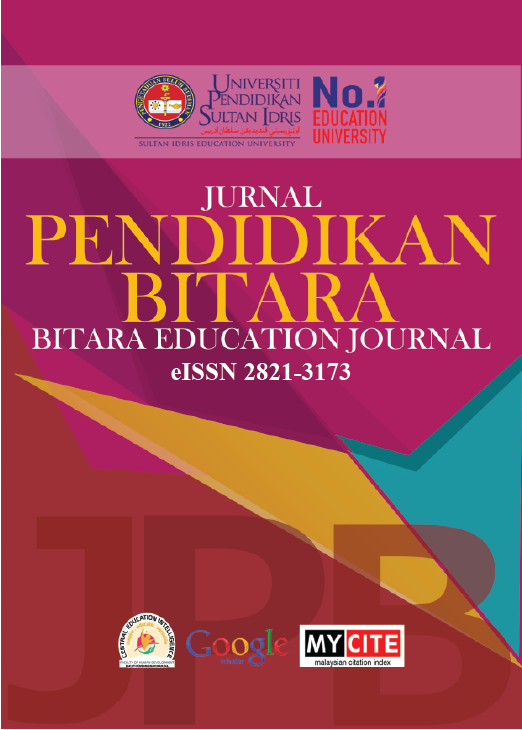A preliminary study on the recommended fitness test on students with visually-impaired: An alternative to SEGAK?
DOI:
https://doi.org/10.37134/bitara.vol13.1.1.2020Keywords:
visually-impaired, health related fitness, fitness test, curl-up test, sit and reach testAbstract
SEGAK Test (Standard Kecergasan Penilaian Kebangsaan) known as the fitness test for students in Malaysia, but the test relevancy with students with disabilities can be questioned. For that, an effort been taking to design a test battery specifically for students with visually-impaired. Purpose of the study was to investigate the differences of fitness level on fitness test protocols on students with visual impairments. For the preliminary study, a total of thirty students (N=30) were selected where 14 were females and 16 were male students aged between 13 to 19 years old and all the participants currently are studying at Sekolah Menengah Pendidikan Khas (cacat penglihatan) Setapak, Kuala Lumpur. The participants were divided into three (3) groups based on the visual impairments classes which are B1, B2 and B3. Therefore, B1 had 12 participants, B2 had 15 participants and B3 had three (3) participants. All the participants were tested with the fitness tests that are a) one-mile run/walk test, b) curl up test, c) isometric push up test and d) sit and reach test. The results revealed that there was no significant difference in BMI, isometric push up, curl up, one-mile run/walk and sit and reach (p > 0.05). In a conclusion, a test battery needs to be designed for students with disabilities especially students with visually-impaired.
Downloads
References
Cattuzzo, M. T., Dos Santos Henrique, R., Ré, A. H. N., De Oliveira, I. S., Melo, B. M., De Sousa Moura, M., Stodden, D. (2016). Motor competence and health related physical fitness in youth: A systematic review. Journal of Science and Medicine in Sport, 19(2), 123-129. https://doi.org/10.1016/j.jsams.2014.12.004
Chen, W., Mason, S., Hammond-Bennett, A., & Zalmout, S. (2016). Manipulative skillcompetency and health-related physical fitness in elementary school students. Journal of Sport and Health Science, 5 (4), 491-499.
https://doi.org/10.1016/j.jshs.2015.03.007
Coledam, D. H. C., Batista, J. P., & Glaner, M. F. (2015). Low agreement between theFitnessgram criterion references for adolescents. Revista Paulista de Pediatria (English Edition), 33(2), 181-186.
https://doi.org/10.1016/S2359-3482(15)30049-X
Erwin, H. E., & Castelli, D. M. (2008). National physical education standards: A summary ofstudent performance and its correlates. Research Quarterly for Exercise and Sport, 79(4),495-505.
King, G., Petrenchik, T., Dewit, D., McDougall, J., Hurley, P., & Law M. (2010). Out- of-school time activity participation profiles of children with physical disabilities: a cluster analysis. Child Care Health Development, 36(5), 726–41. https//doi.org/10.1111/j.1365-2214.2010.01089.
Klavina, A., Ostrovska, K., Campa, M. (2017). Fundamental movement skill and physical fitness measures in children with disabilities. European Federation of Adapted Physical ActivityEuropean.Journal of Adapted Physical Activity, 10(1), 28–37.
Minatto, G., Petroski, E. L., & Silva, D. A. S. (2016). Health-related physical fitness inBrazilian adolescents from a small town of German colonization. Revista Andaluza deMedicina del Deporte, 9(2), 67-74. https://doi.org/10.1016/j.ramd.2014.09.003
Morrow, J. R., Tucker, J. S., Jackson, A. W., Martin, S. B., Greenleaf, C. A., & Petrie, T. A. (2013). Meeting Physical Activity Guidelines and Health-Related Fitness in Youth. American Journal of Preventive Medicine, 44(5), 439-444.
https://doi.org/10.1016/j.amepre.2013.01.008
Nascimento, R. O., Ferreira, L. F., Goulardins, J. B., Freudenheim, A. M., Marques, J. C. B.,Casella, E. B., & Oliveira, J. A. (2013). Health-related physical fitness children with severeand moderate developmental coordination disorder. Research in Developmental Disabilities,34(11), 4222-4231. https://doi.org/10.1016/j.ridd.2013.08.025
Ross, M. S., Bogart, R. K., Logan, S. W., Case, L., Fine, J., & Thompson H. (2016). Physical Activity Participation of disabled children: A systematic review of conceptual and methodological approaches in health research. Frontiers in public health, 4, 187.
Wagner, M.O., Haibach, P. S., & Lieberman, L. J. (2013).Gross motor performance in children with and without visual impairments – Research to practice.Research in Development Disabilities, 34, 3246–3252.
Woodmansee, C., Hahne, A., Imms, C., & Shields, N. (2016).Comparing participation in physical recreation activities between children with disability and children with typical development: A secondary analysis of matched data. Research in Developmental Disabilities, 49–50, 268–276.
Downloads
Published
Issue
Section
License
Copyright (c) 2020 UPSI Press

This work is licensed under a Creative Commons Attribution-NonCommercial-ShareAlike 4.0 International License.





